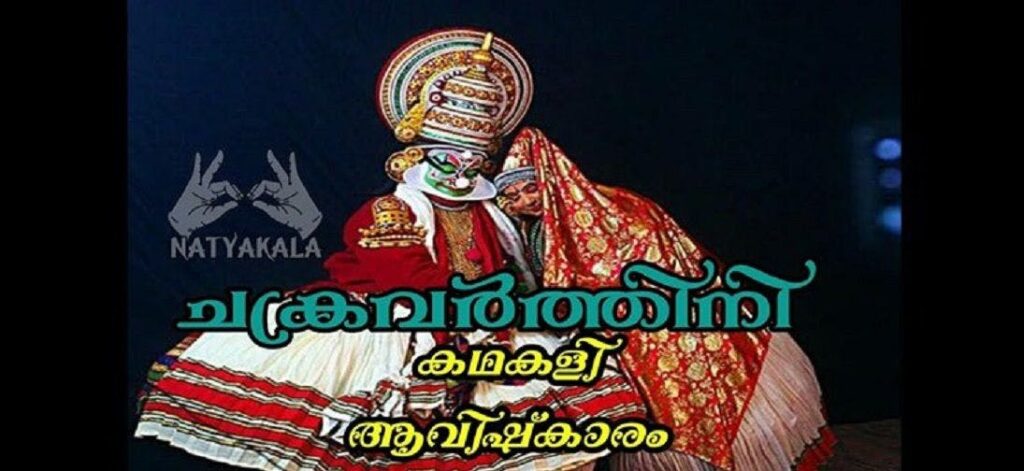The vintage Malayalam movie song, penned by Vayalar and tuned by G Devarajan, has a new avatar in Kathakali, thanks to a team led by Kalamandalam Ganesan.
Five decades after it became a hit song in Malayalam cinema, a different art has adapted Chakravarthini ninakku. Its 20 lines, coming as black-and-white visuals spanning 3.33 minutes, are now in Kathakali. The transformation to Kerala’s dance-theatre timed with the anniversary of the poet who penned the lyrics. Popular Vayalar Ramavarma died on October 27, 1975, aged 47.
The Kathakali version spans 17 minutes, courtesy the classical form’s capacity to elaborate on verses. Cultural circles claim this is the first time a movie number made it to the four-century-old Kathakali repertoire. The classical form has, inversely, been theme for Malayalam movie makers; its stage scenes have found celluloid portrayal. Kathakali artistes have acted in Malayalam movies, too, sometimes in central roles.
The Chakravarthini experiment has no predecessors. The director of the video, though, has come up with several innovations in Kathakali during the past decade.
A new venture in Malayalam movie industry and art world
The idea of staging Chakravarthini came from well-known Malayalam songwriter Beeyar Prsaad who has an interest in Kathakali. He, however, was casual while proposing the idea during a chat with friends two years ago. This summer, the concept looked likely of realisation. Kalamandalam Ganesan, a Kathakali artiste known for his off-beat creations in the dance, began making the moves. He planned to essay Chakravarthini with Kathakali characters as a tribute to Vayalar on his 92nd death anniversary. The popular love song from the1972 movie Chembarathi, scripted by Malayattoor Ramakrishnan, was composed by G Devarajan. It was sung by KJ Yesudas.
The Kathakali version retains the raga. Improvisations apart, the singer duo on stage sticks to Hamir Kalyani that is a scale in Carnatic. The melody isn’t alien to Hindustani music (Kedar) as well as film songs in India. Ganesan, who is a disciple of Kalamandalam Rajasekharan and late Mankompu Sivasankara Pillai, lives in Kalarcode. The place in suburban Alappuzha is 30 km south of Ramavarma’s Vayalar along Kerala’s southcentral coast.
Interestingly, the romantic protagonist in the Kathakali version of the Malayalam movie song comes in Kathi costume associated with the chivalrous antihero. “You may feel the green-hued paccha suits the role best. I have a different opinion,” says middle-aged Ganesan. “Facial expressions of love light up best on the kathi face,” he adds, referring to the make-up that has a stylised moustache.
Ganesan thought of two prospects ahead of giving choreography to the song. One was as a man coming across a beautiful female, only to realise it was all a dream that just got over. The other his thrilling fantasy of the statue of a charming girl coming alive. The team eventually went for Plan-A.
Rehearsal and production
To its core, Chakravarthini is about a youth inviting an empress-like lady to his tastefully chiselled architectural work. The request to remove her floral footwear ahead of the entry is celebrated in literary circles in Kerala and beyond.
Just as Ganesan and fellow artistes thought of the rehearsals, Covid-19 struck. The ensuing shutdown and unlock delayed the schedule. Eventually, the members met in September. The rehearsals organised by Ganesan’s Natyakala institution got on.
Young Varanad Sanalkumar of Cherthala danced as the hero opposite Malavika B Namboodiri. Kalamandalam Sajeevan and Krishna Kumar provided the vocals, while Kalamandalam Akhil (chenda) and Prabhakara Kurup (maddalam) were the percussionists. Kalanilayam Rakesh led a five-member team in the greenroom.
The sustained spread of the pandemic forced Ganesan and his team to give up the idea of presenting the show at Vayalar’s memorial in the sandy compound of the poet’s Raghavaparambil house. Instead, on October 27, the song was uploaded on YouTube. The opening shot has the hand-held curtains being brought down by two bare-chested men on either side. Both wear facemasks, symbolising the gravity of the coronavirus.
Last year, Ganesan presented a Kathakali version of Chinthavishtayaya Seetha on the occasion of the centenary of the path-breaking Malayalam poem by Kumaran Asan. In 2012, he came out with a similar venture based on Chemmeen, a celebrated novel by Thakazhi Sivasankara Pillai.
Between the two productions, in 2015 summer, Ganesan choreographed in Kathakali Ramanan, a pastoral elegy by Changampuzha Krishna Pillai, one of Malayalam’s most influential poets.
Incidentally, a senior artiste had this summer aired on social media a draft of Chakravarthini in Kathakali style. That Facebook video was by multifaceted Sadanam K Harikumaran in April as part of his ongoing ‘mudra’ series on the hand gestures of south Indian classical dances.

